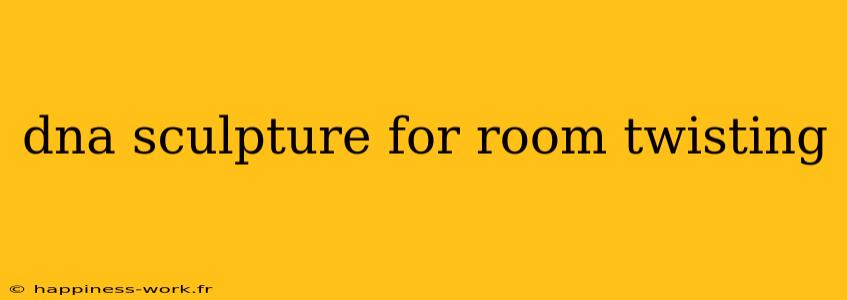In recent years, DNA sculptures have become increasingly popular as unique decorative items that add a scientific flair to any room. These eye-catching designs can make a great conversation starter and can even symbolize the intricate beauty of life itself. This article will explore the concept of DNA sculptures, how they can be created, and practical tips for incorporating them into your home decor.
What is a DNA Sculpture?
A DNA sculpture is an artistic representation of the double helix structure of DNA. Typically designed in three-dimensional formats, these sculptures can be made from various materials such as wood, metal, glass, or plastic. They can serve as educational tools, decorative pieces, or even gifts for science enthusiasts.
Why Choose a DNA Sculpture for Your Room?
- Unique Aesthetic Appeal: Unlike conventional art pieces, DNA sculptures offer a distinctive look that can transform an ordinary space into an extraordinary one.
- Symbolic Meaning: DNA is often considered the blueprint of life. Incorporating a DNA sculpture into your room can reflect your appreciation for science, biology, and the complexity of life.
- Conversation Starter: Having such a unique piece in your home invites curiosity and can lead to interesting discussions with guests.
How to Create a DIY DNA Sculpture
Creating your own DNA sculpture can be a rewarding project. Here's a step-by-step guide based on common practices, adapted for your convenience:
Materials Needed
- Wire: Flexible but sturdy, such as galvanized or aluminum wire.
- Beads or Colored Balls: To represent nucleotides (adenine, thymine, cytosine, and guanine).
- Base: A sturdy base to hold your sculpture, such as wood or heavy cardboard.
- Tools: Wire cutters, pliers, and glue (if needed).
Step-by-Step Guide
-
Design Your Sculpture: Sketch out your design on paper. Consider the size and shape you want your sculpture to take.
-
Cut the Wire: Cut the wire into equal lengths, depending on how tall you want your sculpture to be.
-
Create the Helix: Using your wire, start forming the spiral shape of the double helix. Make sure to twist the wire tightly to achieve a solid structure.
-
Add Beads: Thread your beads onto the wire to represent the nucleotides. Use different colors to distinguish between the base pairs.
-
Secure to Base: Attach the bottom of the sculpture to your chosen base. You can use glue or additional wire to keep it steady.
-
Finishing Touches: Once assembled, you can paint or decorate the base for additional flair.
Practical Example
For instance, a wire sculpture with vibrant beads can add a pop of color to a minimalist room, while a metal version may complement a more industrial decor style. You can also customize the size based on your available space – whether you want a small desk piece or a larger statement art piece.
Decorating with DNA Sculptures
Placement Tips
- Bookshelves: Place your sculpture among books to highlight its scientific theme.
- Desks: Use it as a functional piece, bringing a touch of creativity to your workspace.
- Living Rooms: Incorporate it into a gallery wall alongside other art pieces or photographs.
Seasonal Decor
Consider changing the beads with the seasons or holidays. For example, red and green beads for Christmas or pastel colors for spring. This not only keeps your decor fresh but also shows off your creativity.
Conclusion
A DNA sculpture is a unique and modern addition to any space, blending art and science seamlessly. Whether you choose to create one yourself or purchase a ready-made design, it can add character and provoke thought in your home. As you experiment with design and placement, let your creativity flourish and embrace the beauty of DNA in your decor.
References
This guide is inspired by the collaborative contributions of authors from WikiHow. For more detailed techniques on DIY projects, visit their resource-rich platform.
Incorporating a DNA sculpture into your home decor not only enhances your space but also showcases your interest in science and creativity. Happy crafting!
